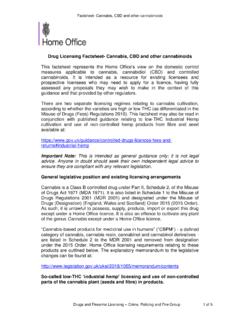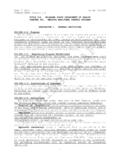Transcription of THE HEALTH EFFECTS OF CANNABIS AND CANNABINOIDS
1 THE HEALTH EFFECTS OF CANNABIS AND CANNABINOIDS . COMMITTEE'S CONCLUSIONS Januar y 2017. In the report The HEALTH EFFECTS of CANNABIS and CANNABINOIDS : The Current State of Evidence REPORT. and Recommendations for Research, an expert, ad hoc committee of the National Academies of Sciences, Engineering, and Medicine presents nearly 100 conclusions related to the HEALTH The HEALTH EFFECTS EFFECTS of CANNABIS and cannabinoid use. of CANNABIS and CANNABINOIDS THE CURRENT STATE OF EVIDENCE AND. RECOMMENDATIONS FOR RESEARCH. The committee developed standard language to categorize the weight of the evidence regarding whether CANNABIS or CANNABINOIDS used for therapeutic purposes are an effective or ineffective treatment for certain prioritized HEALTH conditions, or whether CANNABIS or CANNABINOIDS used primarily for recreational purposes are statistically associated with certain prioritized HEALTH conditions.
2 The box on the next page describes these categories and the gen- eral parameters for the types of evidence supporting each category. The numbers in parentheses after each conclusion correspond to chapter conclusion numbers. Each blue header below links to the corresponding chapter in the report, providing much more detail regarding the committee's findings and conclusions. To read the full report, please visit CONCLUSIONS FOR: THERAPEUTIC EFFECTS . There is conclusive or substantial evidence that CANNABIS or CANNABINOIDS are effective: For the treatment for chronic pain in adults ( CANNABIS ) (4-1). Antiemetics in the treatment of chemotherapy-induced nausea and vomiting (oral CANNABINOIDS ) (4-3).
3 For improving patient-reported multiple sclerosis spasticity symptoms (oral CANNABINOIDS ) (4-7a). There is moderate evidence that CANNABIS or CANNABINOIDS are effective for: Improving short-term sleep outcomes in individuals with sleep disturbance associated with obstructive sleep apnea syndrome, fibromyalgia, chronic pain, and multiple sclerosis ( CANNABINOIDS , primarily nabiximols) (4-19). There is limited evidence that CANNABIS or CANNABINOIDS are effective for: Increasing appetite and decreasing weight loss associated with HIV/AIDS ( CANNABIS and oral CANNABINOIDS ) (4-4a). Improving clinician-measured multiple sclerosis spasticity symptoms (oral CANNABINOIDS ) (4-7a).
4 Improving symptoms of Tourette syndrome (THC capsules) (4-8). Improving anxiety symptoms, as assessed by a public speaking test, in individuals with social anxiety disorders (cannabidiol). (4-17). Improving symptoms of posttraumatic stress disorder (nabilone; one single, small fair-quality trial) (4-20). There is limited evidence of a statistical association between CANNABINOIDS and: Better outcomes ( , mortality, disability) after a traumatic brain injury or intracranial hemorrhage (4-15). There is limited evidence that CANNABIS or CANNABINOIDS are ineffective for: Improving symptoms associated with dementia ( CANNABINOIDS ) (4-13).
5 Improving intraocular pressure associated with glaucoma ( CANNABINOIDS ) (4-14). Reducing depressive symptoms in individuals with chronic pain or multiple sclerosis (nabiximols, dronabinol, and nabilone). (4-18). DEFINITIONS OF WEIGHTS OF EVIDENCE. The committee used the following standardized language to categorize the weight of the evidence regarding CANNABIS or cannabinoid use for the prioritized HEALTH conditions: CONCLUSIVE evidence For therapeutic EFFECTS : There is strong evidence from randomized controlled trials to support the conclusion that CANNABIS or CANNABINOIDS are an effective or ineffective treatment for the HEALTH endpoint of interest.
6 For other HEALTH EFFECTS : There is strong evidence from randomized controlled trials to support or refute a statistical association between CANNABIS or cannabinoid use and the HEALTH endpoint of interest. For this level of evidence, there are many supportive findings from good-quality studies with no credible opposing findings. A firm conclusion can be made, and the limitations to the evidence, including chance, bias, and confounding factors, can be ruled out with reasonable confidence. SUBSTANTIAL evidence: For therapeutic EFFECTS : There is strong evidence to support the conclusion that CANNABIS or CANNABINOIDS are an effective or ineffective treatment for the HEALTH endpoint of interest.
7 For other HEALTH EFFECTS : There is strong evidence to support or refute a statistical association between CANNABIS or cannabinoid use and the HEALTH endpoint of interest. For this level of evidence, there are several supportive findings from good-quality studies with very few or no credible opposing findings. A firm conclusion can be made, but minor limitations, including chance, bias, and confounding factors, cannot be ruled out with reasonable confidence. MODERATE evidence: For therapeutic EFFECTS : There is some evidence to support the conclusion that CANNABIS or CANNABINOIDS are an effective or ineffective treatment for the HEALTH endpoint of interest.
8 For other HEALTH EFFECTS : There is some evidence to support or refute a statistical association between CANNABIS or cannabinoid use and the HEALTH endpoint of interest. For this level of evidence, there are several findings from good- to fair-quality studies with very few or no credible opposing findings. A general conclusion can be made, but limitations, including chance, bias, and confounding factors, cannot be ruled out with reasonable confidence. LIMITED evidence: For therapeutic EFFECTS : There is weak evidence to support the conclusion that CANNABIS or CANNABINOIDS are an effective or ineffective treatment for the HEALTH endpoint of interest.
9 For other HEALTH EFFECTS : There is weak evidence to support or refute a statistical association between CANNABIS or cannabinoid use and the HEALTH endpoint of interest. For this level of evidence, there are supportive findings from fair-quality studies or mixed findings with most favoring one conclusion. A conclusion can be made, but there is significant uncertainty due to chance, bias, and confounding factors. NO or INSUFFICIENT evidence to support the association: For therapeutic EFFECTS : There is no or insufficient evidence to support the conclusion that CANNABIS or CANNABINOIDS are an effective or ineffective treatment for the HEALTH endpoint of interest.
10 For other HEALTH EFFECTS : There is no or insufficient evidence to support or refute a statistical association between CANNABIS or cannabinoid use and the HEALTH endpoint of interest. For this level of evidence, there are mixed findings, a single poor study, or HEALTH endpoint has not been studied at all. No conclusion can be made because of substantial uncertainty due to chance, bias, and confounding factors. 2. There is no or insufficient evidence to support or refute the conclusion that CANNABIS or CANNABINOIDS are an effective treatment for: Cancers, including glioma ( CANNABINOIDS ) (4-2). Cancer-associated anorexia cachexia syndrome and anorexia nervosa ( CANNABINOIDS ) (4-4b).


